Mine Action and South-South Cooperation: Case of JICA and CMAC
Hayashi Ontoku Akihito [ Japan International Cooperation Agency ]
CISR Journal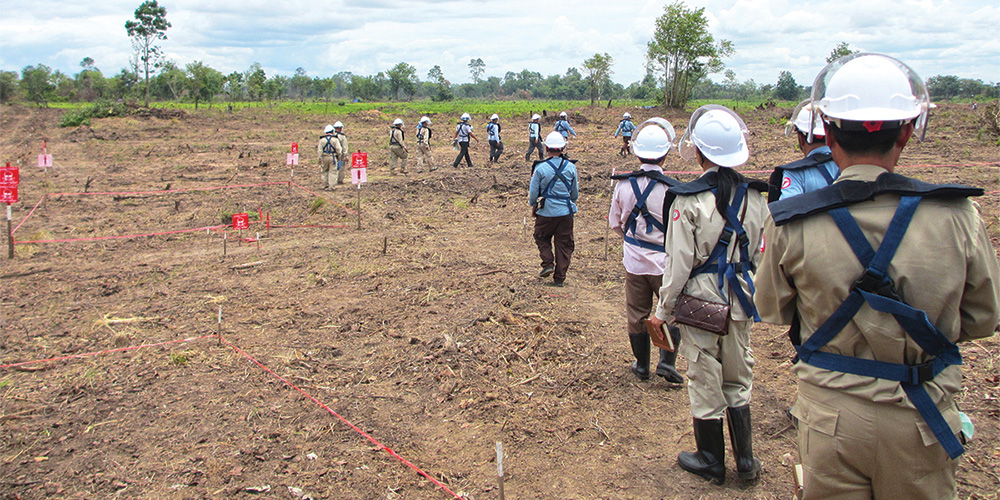
This article is brought to you by the Center for International Stabilization and Recovery (CISR) from issue 27.2 of The Journal of Conventional Weapons Destruction available on the JMU Scholarly Commons and Issuu.com
South-South cooperation has been pursued across various fields of international development. However, there has been a paucity of efforts to promote South-South cooperation in mine action. Japan International Cooperation Agency (JICA) and Cambodia Mine Action Centre (CMAC) have been at the forefront of expanding South-South and global cooperation by leveraging CMAC's extensive experience and expertise accumulated over its thirty years’ of operation. This article delves into the motives and mechanisms behind JICA’s and CMAC's joint efforts to foster this collaboration.
INTRODUCTION
Many developing countries facing severe landmine and unexploded ordnance (UXO) contamination have experienced conflict and struggle with poverty. Despite this, several countries have made efforts to strengthen their national capacity and ownership of mine action programs.
Cambodia is one such example. Having overcome the tragedy of thirty years’ of conflict, Cambodia has built institutional and organizational foundations to address the landmine and UXO issue with assistance from the international community. Presently, the country actively engages in mine action with a strong sense of national ownership. Cambodia's experience is a valuable resource for the global mine action community. This first-hand knowledge acquired by one of the most heavily contaminated countries can be leveraged for resolving similar issues in other countries with mine and UXO contamination.
BACKGROUND OF JICA'S SUPPORT IN CMAC'S SOUTH-SOUTH COOPERATION
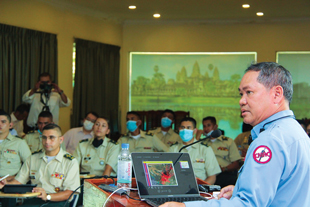
CMAC deputy director general giving a presentation to Colombian participants. Courtesy of CMAC.
JICA has supported CMAC in a variety of ways, including supplying demining equipment and providing technical assistance. Over the past ten years, JICA has broadened its focus to include South-South/Triangular cooperation, with CMAC sharing its expertise. South-South cooperation is believed to be one example of an effective and efficient solution to the global landmine and UXO issue. By transferring expertise from countries with extensive experience to those with less experience, mine-affected countries can acquire immediate skills and knowledge without having to follow the difficult path of capacity building from scratch.
The experience and skills accumulated by CMAC have enabled this approach. CMAC has engaged in mine action since its inception under the United Nations Transitional Authority in Cambodia in 1992. Since then, CMAC has significantly developed its capacity, releasing and clearing more than 200 km2 of contaminated land annually, and disposing of three million landmines and UXO. CMAC has strived to improve its operational efficiency by applying the concept of a “Toolbox,” which employs a range of methods such as heavy machines, mine detection dogs, and different types of detectors.
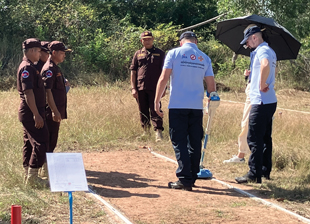
Ukrainian deminer using ALIS during training in Cambodia. Courtesy of Hayashi Ontoku Akihito.
HISTORY OF COOPERATION
JICA and CMAC initiated South-South cooperation with the aim of sharing Cambodia's experience with other mine-affected countries. The first program began with Colombia in 2010, followed by other countries such as Laos, Iraq, and Angola in subsequent years. More than thirty programs have been implemented with over 500 participants. A recent development is the training program for Ukraine deminers on Advance Landmine Imaging System (ALIS), a hand-held dual sensor device for detecting anti-personnel landmines.
PROGRAM OVERVIEW
Colombia
- 2010–2011: 3 programs / 45 particiapnts
- 2017–2022 (second phase): 7 programs / 118 participants
- 2023–2025 (third phase): TBD / TBD
Lao PDR
- 2012–2014 (first phase): 6 programs / 100 participants
- 2015–2018 (second phase): 5 programs / 30 participants
- 2019–2024 (third phase): 6 programs / 42 participants
Angola
- 2012–2015: 4 programs / 51 participants
Iraq
- 2016–2020: 7 programs / 175 participants
Ukraine
- 2020: 1 program/8 participants
A UNIQUE APPROACH TO ADDRESSING CONTAMINATION
There are several notable characteristics of the programs implemented under the cooperation.
Comprehensiveness. More specifically, programs are divided into three categories according to their target and theme. The first category focuses on the institutional and organizational development of the mine action program in Cambodia, offering government policymakers, and mine action authorities and centers, a comprehensive understanding of the long-term strategy for developing their mine action program. The second category focuses on sharing management strategies for running organizations with senior and middle management officials. This provides an overview of how CMAC was established, as well as an overall snapshot of how the organization is managed. The third category aims to impart specific field operation skills and methodologies, such as land release, mechanical clearance, and animal detection, which are relevant for technical and field staff of partner organizations.
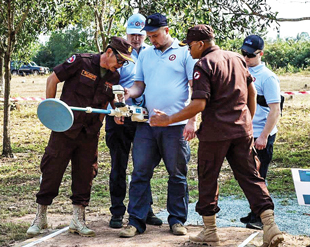
CMAC trainer (left) explaining how to use ALIS to Ukrainian deminers during training in Cambodia. Courtesy of CMAC.
Modality. The agendas are systematically and flexibly designed and implemented, with a program’s framework determined under the facilitation of JICA. During the preparatory stage, the three parties—JICA, CMAC, and a partner organization—decide on the overall program structure, including format, theme, and duration, based on the requests and needs received from the partner organization. CMAC accordingly develops and prepares relevant course content, schedules, and training materials before a program commences. In addition, the three parties have a mid-term review and conduct a final review at the end of the series of programs to evaluate the overall process and outcomes.
Adaptability. A program’s format is designed and adjusted depending on the requirements and anticipated outcomes of partner organizations. Officials from a partner organization visit Cambodia to participate in CMAC-led programs that combine lectures and field training. Alternatively, an exchange program between CMAC and a partner organization can be arranged, in which participants from both organizations visit each other and exchange experiences on a specific theme. This allows both organizations to collaborate and learn from each other. CMAC also sends its experts to partner countries such as Colombia and Ukraine to provide training, enabling CMAC staff to observe a partner organization’s operations and provide constructive feedback.
TYPES OF PROGRAMS
Type 1: Institutional and Organizational Development of Cambodia's Mine Action
- Target
- Policymaker and senior management officials of national mine action authorities and mine action centers
- Theme
- Sharing Cambodian experience in the institutional and organizational development of mine action in Cambodia
- Linking mine action with development
Type 2: Management of National Mine Action Authority and Mine Action Center
- Target
- Senior and middle management officials of national mine action authorities and mine action centers
- Theme
- Senior/middle management
- Quality management, SOP's, and national standards
- Project management
- Human resource management
- Operational management
- Information management
- Training management
Type 3: Field Operation and Technique
- Target
- Middle management and field staff of national mine action centers
- Theme
- Land release (Non-technical survey, Technical survey, clearance)
- Mechanical landmines clearance and operation
- EOD Level 3
- Battle area clearance (BAC)
- Mine risk education
- Mine detection dog
OUTCOMES
Positive outcomes have been identified through the mid-term and final reviews of past programs. Firstly, the programs under the cooperation have initiated national ownership of partner countries. Participants have learned from CMAC’s experiences, particularly their efforts to develop an institutional and organizational structure to address the country’s explosive ordnance (EO) contamination. Officials from a partner country confirmed during a review that they developed their strategic mine action plan based on the reviews of previous programs.
Secondly, the programs have strengthened capacity development of national mine action authorities. A wide range of capacities is required of national mine action organizations, including resource mobilization, national standards development, quality management training, and efficient information management. A successful case involves a partner organization developing the national training standard based on what they have learned from other programs. CMAC, as the national operator in Cambodia, has developed various capacities throughout its history, which contribute to the comprehensive capacity building of partner organizations.
Finally, through South-South cooperation, the programs have successfully provided partner organizations with skills and technologies that are readily applicable in the field. For example, CMAC has organized initial trainings for partner organizations to acquire skills in using mechanical clearance machines, which have been employed in Cambodia for many years and were newly introduced to partner countries.
UKRAINE
In 2023, the collaboration between CMAC and JICA took on a new dimension as the cooperation expanded into Ukraine as part of a multi-component cooperation with the State Emergency Service of Ukraine (SESU). Japan, which had been exploring ways to support mine action operations in Ukraine, and in consultation with CMAC, conducted initial practical training for Ukrainian deminers on the use of the ALIS detector in January. Developed in partnership between CMAC and Tohoku University, ALIS is a detection device equipped with ground penetrating radar (GPR), which enables a deminer to distinguish whether an object underground is a landmine or a metallic fragment. The use of ALIS is expected to increase the efficiency of clearance work in Ukraine. CMAC conducted a one-week training for eight members from SESU, including members from the Interregional Center for Humanitarian Demining and Rapid Response, and Pyrotechnic Units in Kyiv, Kharkiv, and Khmelnytskyi. ALIS requires a certain amount of time to master the device. Thus, the second training is scheduled to be conducted in 2023 to ensure the practical application of the device. In addition to ALIS, Japan is considering providing other kinds of demining equipment such as heavy machines to Ukraine.
CHALLENGES
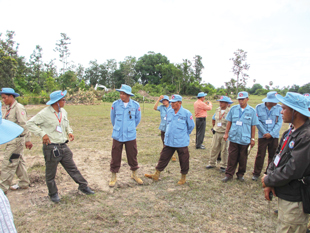
UXO Lao participants speaking with CMAC staff during a field visit in Cambodia. Courtesy of Hayashi Ontoku Akihito.
The South-South cooperation programs implemented thus far have made significant strides; however, certain challenges persist. It’s important to note two issues: Firstly, it is imperative to factor in the context of the partner country. Prior programs have mainly focused on conveying CMAC's expertise, which has led to programs that were not adequately tailored to the partner country's unique circumstances. Moving forward, it is essential to establish programs that account for the partner country's situation and enhance various approaches, such as consultancy work to respond to their unique needs.
Secondly, it is important to support the organizational commitment of partner institutions. According to feedback from participants, individuals sometimes face difficulties in applying the knowledge they have gained upon returning to their home countries. This is due to limited support in the workplace, making it challenging for individuals to drive changes within the organization. Therefore, individuals must be supported when returning to an organization in an effort to enhance an organization’s commitment to create receptive working environments. This requires sharing goals among the relevant parties during the program formation stage and augmenting follow-up activities after its completion.
CONCLUSION
Mine-affected countries can greatly contribute to other countries’ success in addressing their contamination. Gaining from their experiences, successes, and lessons learned is a step forward in helping countries address EO contamination. With this in mind, it is anticipated that the expansion of South-South cooperation in the mine action sector will persist.
HAYASHI ONTOKU AKIHITO
Advisor
Japan International Cooperation Agency (JICA) / Cambodian Mine Action Centre (CMAC)
 Hayashi Ontoku Akihito is a Japan International Cooperation Agency (JICA) advisor to the Cambodian Mine Action Centre (CMAC). He began his work as an advisor to CMAC in 2020 and is responsible for a technical cooperation project supported by JICA to strengthen the functional capacity of CMAC. He is also coordinating the South-South cooperation program. Before joining CMAC, he worked with UXO Lao from 2012 to 2018 and was in charge of a JICA project to develop UXO Lao’s capacity.
Hayashi Ontoku Akihito is a Japan International Cooperation Agency (JICA) advisor to the Cambodian Mine Action Centre (CMAC). He began his work as an advisor to CMAC in 2020 and is responsible for a technical cooperation project supported by JICA to strengthen the functional capacity of CMAC. He is also coordinating the South-South cooperation program. Before joining CMAC, he worked with UXO Lao from 2012 to 2018 and was in charge of a JICA project to develop UXO Lao’s capacity.
| Stay updated | |||
